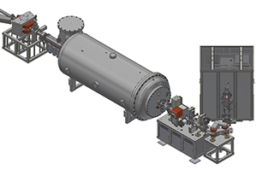A research group at the University of Tokyo and Sharp Corp developed a
quantum dot-type photovoltaic (PV) battery with a high efficiency.
Its
cell conversion efficiency is 18.7% without light condensing and 19.4%
at the time of 2x light condensing. The research group is led by
Yasuhiko Arakawa and Katsuaki Tanabe, who are professor and
specially-appointed associate professor, respectively, at the Institute
for Nano Quantum Information Electronics, the University of Tokyo.
The
18.7% efficiency is the industry’s highest efficiency for a quantum
dot-type PV battery that is not concentrating light, Arakawa said.
Before the achievement was made, the highest efficiency had been 18.3%
achieved by a research group at the Russian Academy of Sciences.
The
latest quantum dot-type PV battery was developed by using the
“intermediate band method,” in which conversion efficiency is improved
by forming a superlattice structure (in which quantum dots are
three-dimensionally arranged) and a miniband (intermediate band) that
absorbs infrared light. According to the estimate that the research
group made in 2011, in theory, it is possible to improve the cell
conversion efficiency to about 80% by forming more than three
intermediate bands.
This
time, the group and Sharp stacked five InGaAs/GaAs-based quantum dot
layers on a GaAs substrate by using the MOCVD (metal organic chemical
vapor deposition) method. There are two reasons why the high cell
conversion efficiency was achieved, they said.
First,
they prevented the formation of energy levels that trap electrons and
lower conversion efficiency by optimally controlling the size of quantum
dot, etc. Second, they optimized the design of the antireflection film
(MgF2/ZnS film) formed on the surface of the cell.
The open voltage of the newly-developed PV cell is 0.9 V, and its fill factor (FF) is 0.8.
“(For
the future), we will use GaN or InGaAsP, whose band gaps are larger
than that of GaAs, as the base material of quantum dot,” Arakawa said.
“And we will optimize the number of quantum dot layers and the quality
of the base material to increase cell conversion efficiency to 30 to
40%.”
This
time, the university and Sharp also succeeded in forming a quantum
dot-type PV battery on a flexible substrate for the first time in the
industry, they said. They grew 10 InAs/GaAs quantum dot layers by using
the molecular beam epitaxy (MBE) method on a GaAs substrate.
Then,
it was turned upside down and attached to a resin (polyimide)
substrate. By using a conductive epoxy material based on silver (Ag)
nanoparticles as an adhesive material, it became possible to firmly
attach it even at a temperature of 200 C or lower.
The
employment of the resin substrate made it possible to bend the battery
and reduced the weight of the cell to 0.028g/cm2, which is 90% lighter
than the cell formed on the GaAs substrate. Its cell conversion
efficiency is about 10%.
The
University of Tokyo and Sharp will announce the research results at an
event that is organized by the Japan Society of Applied Physics and runs
from March 15 to 18, 2012, at Waseda University (lecture numbers:
18a-C1-8 (the quantum dot-type PV battery with the industry’s highest
efficiency) and 18a-C1-9 (the quantum dot-type PV battery on the
flexible substrate)).
Source: Nikkei Electronics




